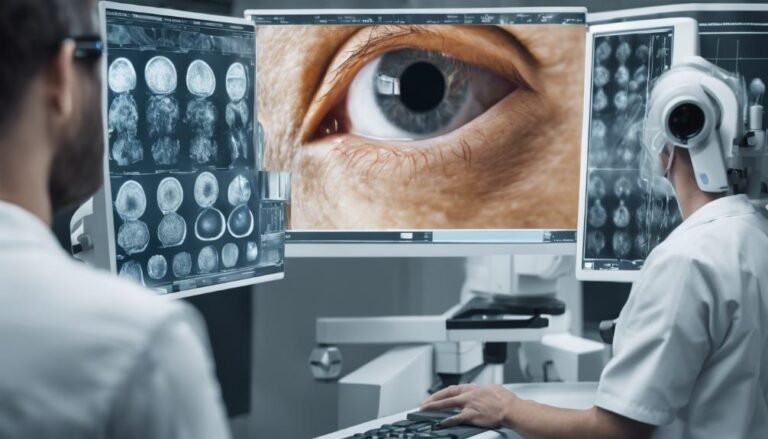AI in Healthcare Robotics
As you contemplate the various advancements in healthcare, it's intriguing how AI seamlessly integrates with robotics to redefine patient care. The synergy between artificial intelligence and robotic systems is reshaping the landscape of healthcare delivery, offering unparalleled precision and efficiency. Imagine a world where AI-driven robots collaborate with medical professionals to provide personalized treatments and perform complex surgeries with unmatched accuracy. The potential for innovation and transformation in healthcare robotics is boundless, with implications that could revolutionize the future of medicine.
Key Takeaways
- AI enhances surgical precision and efficiency in operating rooms.
- Real-time monitoring of patient critical signs and treatment progress.
- Improves diagnostic capabilities through remote monitoring and AI algorithms.
- Streamlines patient care management for personalized treatment plans.
- AI robots streamline administrative tasks for operational efficiency.
The Role of AI in Healthcare Robotics
AI plays a crucial role in enhancing the capabilities and efficiency of healthcare robotics systems. Through the integration of AI, healthcare robotics can achieve significant cost efficiency and streamline operations.
Remote monitoring, facilitated by AI algorithms, allows for continuous patient surveillance, enabling early detection of potential health issues and timely interventions. This real-time monitoring reduces the need for constant human oversight, optimizing resource allocation and enhancing overall patient care.
Moreover, AI-driven healthcare robotics systems are revolutionizing precision surgery. By leveraging advanced data analytics, these systems can process vast amounts of patient data to provide surgeons with real-time insights and guidance during procedures. This not only enhances surgical accuracy but also minimizes the risk of human error, leading to improved patient outcomes and faster recovery times.
Advantages of AI Integration
Incorporating artificial intelligence into healthcare robotics systems offers a myriad of benefits, enhancing efficiency and precision in medical interventions. The integration of AI leads to significant efficiency benefits by streamlining processes, optimizing resource allocation, and reducing human error.
Through AI-powered algorithms, healthcare robots can analyze vast amounts of data quickly, enabling real-time monitoring of patient critical signs and treatment progress. This real-time monitoring enhances patient care by providing timely interventions and adjustments as needed.
Moreover, the precision accuracy achieved through AI integration guarantees that medical procedures are carried out with the highest level of accuracy, minimizing risks and complications. This precision not only improves patient outcomes but also contributes to substantial cost savings in the long run by reducing the need for corrective measures or prolonged hospital stays.
Applications in Surgical Procedures
Enhancing surgical precision and outcomes, AI-driven healthcare robotics systems revolutionize the landscape of surgical procedures. Robotic assisted surgeries powered by AI algorithms have greatly enhanced efficiency and precision in the operating room. These systems provide real-time monitoring of crucial parameters, allowing for immediate adjustments during the procedure to guarantee excellent results.
By integrating AI into surgical procedures, robotic systems can perform tasks with a level of accuracy that surpasses human capabilities. AI algorithms analyze data from various sources, such as preoperative imaging and patient essentials, to assist surgeons in making informed decisions during the operation. This real-time feedback loop enables adjustments to be made swiftly, leading to improved patient outcomes and reduced surgical complications.
The use of AI-driven healthcare robotics in surgical procedures not only streamlines processes but also enhances the overall quality of care provided to patients. With the ability to perform complex tasks with precision and efficiency, these systems are reshaping the future of surgery.
Enhancing Diagnostic Capabilities
To advance beyond surgical procedures, the integration of AI and robotics in healthcare now focuses on enhancing diagnostic capabilities. Through the use of AI algorithms and robotics, healthcare providers can now leverage remote monitoring to track patients' health data continuously.
This remote monitoring allows for real-time data analysis, enabling early detection of potential health issues before they escalate.
AI-powered diagnostic tools can analyze vast amounts of patient data, including medical history, test results, and imaging scans, to assist healthcare professionals in making accurate and timely diagnoses. By leveraging machine learning algorithms, these tools can identify patterns and trends that may not be apparent to human healthcare providers, leading to improved diagnostic accuracy.
Moreover, robotics can be utilized to perform complex diagnostic procedures with precision and efficiency. For instance, robotic systems equipped with advanced imaging technologies can conduct minimally invasive procedures for early detection of diseases such as cancer.
Integrating AI and robotics in diagnostic processes not only enhances accuracy but also improves the overall efficiency of healthcare delivery.
Improving Patient Care Management
AI and robotics technologies are revolutionizing patient care management by streamlining processes and optimizing treatment plans. Through remote monitoring capabilities, healthcare robotics can track patient data in real-time, allowing for personalized treatment plans tailored to individual needs. This level of personalized care leads to better patient outcomes and improved overall satisfaction.
Data analytics play an essential role in enhancing patient care management. By analyzing vast amounts of patient data, AI algorithms can identify patterns and trends that human analysis may overlook. This analytical power enables healthcare providers to make more informed decisions and predict potential outcomes with greater accuracy.
Predictive outcomes generated by AI help in preemptive interventions, reducing the likelihood of adverse events and improving patient safety.
Addressing Challenges and Concerns
One challenge that arises in the implementation of AI in healthcare robotics is the need to address concerns regarding data privacy and security measures. As AI systems in medical robotics handle sensitive patient data, guaranteeing ethical considerations and regulatory compliance is paramount. Ethical considerations encompass the responsible use of AI algorithms to make decisions that align with patient well-being.
Regulatory compliance involves adhering to laws and guidelines set forth to safeguard patient information and maintain the integrity of healthcare operations.
To mitigate these challenges, healthcare organizations must implement robust data encryption protocols, access controls, and regular security audits. Additionally, developing transparent policies on data collection, storage, and sharing can enhance trust between patients and AI-driven healthcare systems.
Continuous monitoring of AI algorithms for biases and errors is essential to uphold ethical standards and ensure fair treatment of all patients.
Future Trends in Medical Robotics
Looking ahead, the integration of advanced sensors and real-time data analytics is poised to revolutionize the field of medical robotics. Future trends in medical robotics are shifting towards enhancing remote monitoring and telemedicine capabilities. By leveraging wearable technology, medical robots can provide personalized care tailored to individual patient needs.
Remote monitoring allows healthcare providers to track patient health metrics continuously, enabling early detection of potential issues and timely interventions. Medical robots equipped with advanced sensors can collect and transmit real-time data to healthcare professionals, facilitating remote consultations and reducing the need for in-person visits.
Telemedicine, combined with medical robotics, opens up new possibilities for delivering healthcare services to underserved areas and improving access to specialized care. Wearable technology integrated into medical robots enables the collection of essential signs, activity levels, and other relevant data, empowering healthcare providers to offer personalized care regardless of physical location.
As these technologies continue to evolve, the future of medical robotics holds promise for transforming healthcare delivery and improving patient outcomes.
Conclusion
To sum up, AI in healthcare robotics is transforming the landscape of patient care with unparalleled precision and efficiency. Despite concerns about job displacement, envision a future where robotic assistants work seamlessly alongside healthcare professionals, enhancing diagnostic accuracy and surgical precision.
With AI-driven technologies driving progress in medical robotics, the future of healthcare promises a seamless integration of human expertise and cutting-edge innovation to provide excellent patient outcomes.







